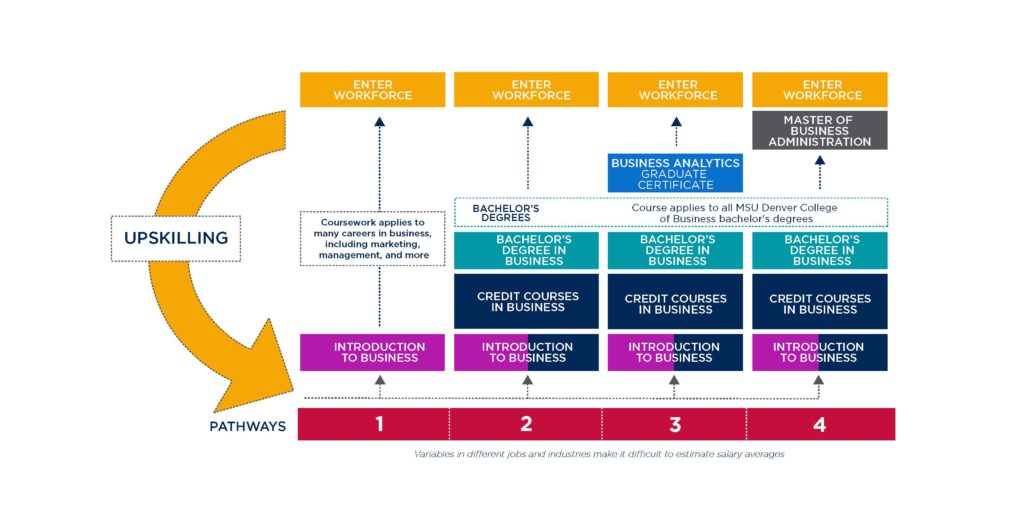Last updated on May 21, 2024
We all want our students to leave our classes prepared to excel in their careers. To ensure this, educators work tirelessly to ensure that their students have relevant knowledge and marketable skills.
As our students transition into or continue their careers, they find that employers want to know that they have the skills their profession needs and might look for credentials beyond a diploma to evaluate their abilities. One strategy for preparing today’s students for tomorrow’s job market are stackable courses like BUS 1850: Introduction to Business.
What are stackable courses? These innovative learning experiences, offered through Innovative and Lifelong Learning, allow students additional pathways to help further their career by engaging in low cost, non-credit learning experiences that result in valuable credentials. Even better, students can choose to continue their learning by “stacking” on an additional credit portion of their learning experience that can help them earn a certificate or bachelor’s degree.
One of the important goals of stackable credentialing is learning directly transferable job skills. As such, BUS 1850 was designed with tight industry alignment and real-world applicability in mind. Possible career paths and different business sectors, roles, and positions are highlighted, and students are engaged with real world stories of businesses and entrepreneurs. This all adds relevance to the information taught in this course. To add to the authenticity of the learning experience, assessments are designed to reinforce lessons learned and allow for the direct transfer of what has been learned into practical job skills.
All of this is bolstered by instruction from an expert with years of business experience. Robert Farmer, MSP (“Coach Bob”) is an internationally known Business and Career Coach. A graduate of University of Denver – University College with a Master’s of Professional Studies in Organizational Leadership, Coach Bob has been instructing at MSU Denver for the past twelve years in the College of Business.

Contents
Showcase Examples
Example 1- Industry Outcomes and Pathways
- Adult learners often want to know the value of what they are learning – the “so what” which often determines a learner’s motivation. Stackable courses provide industry alignment graphics that clearly show how completing the course can help students advance in the industry and/or prepare for additional coursework.
- The course includes a graphic showing how the Introduction to Business class prepares students to immediately enter the workforce (Pathway 1), to take additional courses and earn their bachelor’s degree in business (Pathway 2), to earn a bachelor’s degree and a business analytics graduate certificate (Pathway 3), or to earn a bachelor’s degree and a master of business administration degree (Pathway 4).

Example 2- Relevant and Timely OER
- The course uses a free Open Educational Resource (OER) textbook, lectures, and videos that illustrate content using timely real-world examples at no additional cost to learners. The textbook includes references to famous brands, companies, and entrepreneurs to make learning relevant and timely. For more information on finding and implementing OER in your own course, please view our Find Open Educational Resources and Use Them in Canvas spotlight.
Example 3- Applicable Business Plan Activity
- BUS 1850 is designed with the real business environment in mind. The course culminates in the development of a business plan, in which students conceptualize an imagined business. Learners go through all the steps needed to create a real business plan, including describing the business environment, determining how the business will be financed, and describing plans for marketing, management, and production.
- The process of creating an authentic business plan allows students to construct their own understanding and prepares them for similar assignments in their future careers. This is an example of near transfer, which describes a learner’s ability to transfer what they have learned in an educational environment to a real-world environment. The more authentic the activity in the course, the more successful a student will be when encountering a similar real-world task.
- By allowing students to generate their own ideas for potential business, this project also provides a great example of constructivist learning.
Partnering for Continuous Improvement in Teaching and Learning
A significant factor in the success of this and similar projects is the support and funding from the Office of Online Learning (OOL), which has been instrumental in enhancing the quality of our online educational endeavors. OOL’s support and contributions have empowered faculty members to innovate and create a more enriching educational environment for all. Please visit the Office of Online Learning for more information about all that they are doing to help MSU Denver faculty members and students.
Want to get involved?
For more information on how to design and build a course with the CTLD Instructional Design Group, please visit our CTLD Course Development Cycle Spotlight.